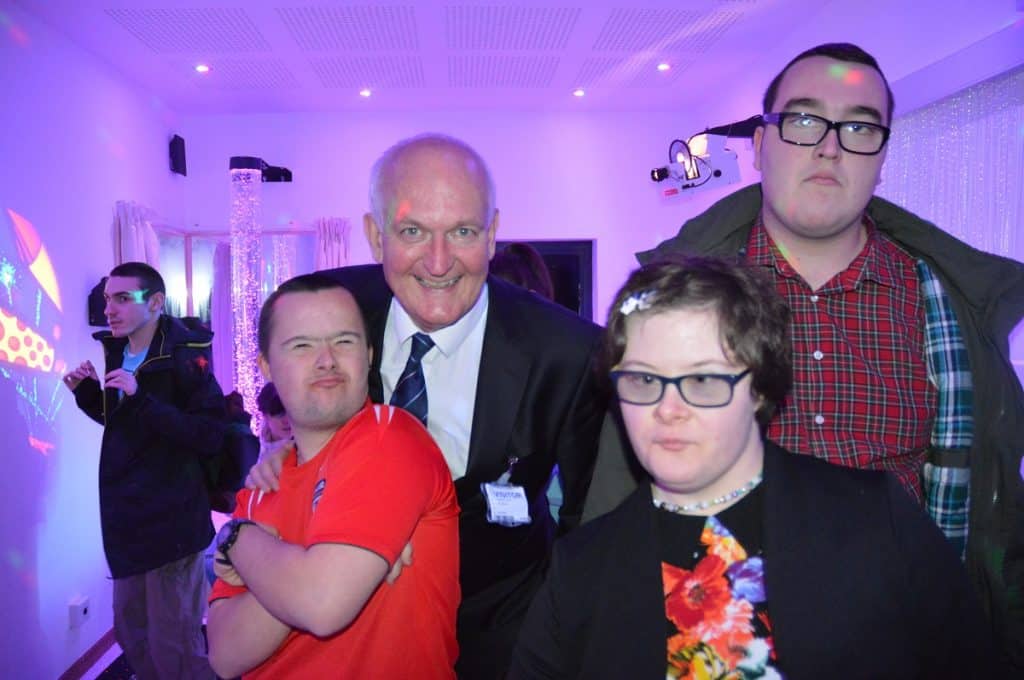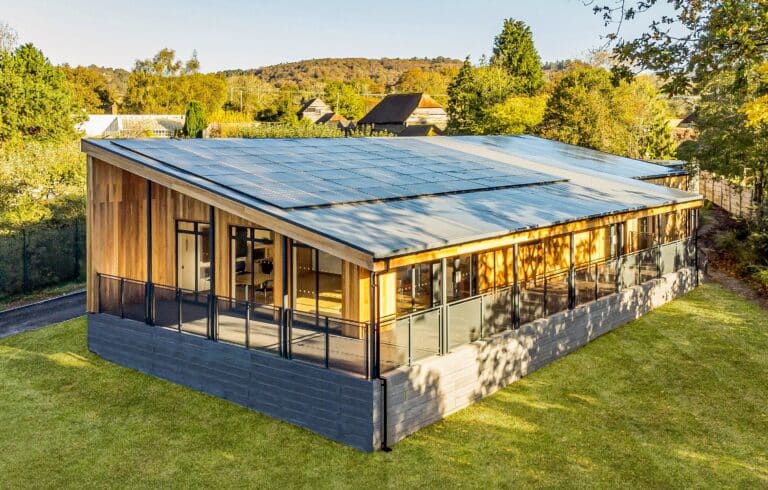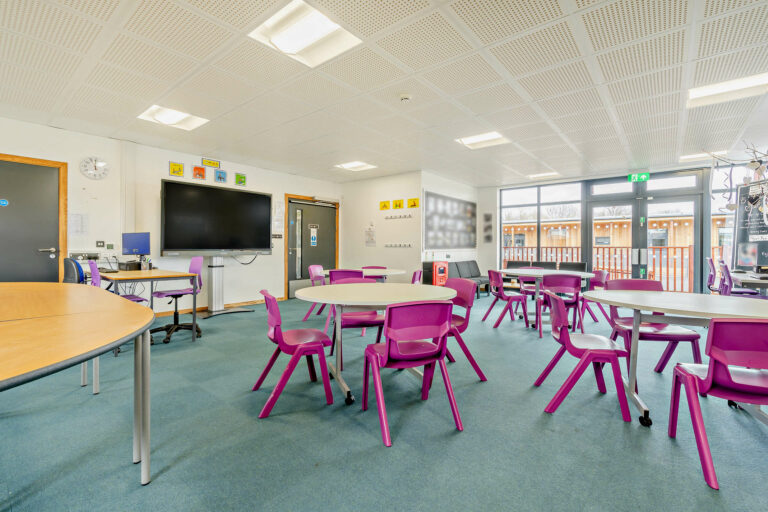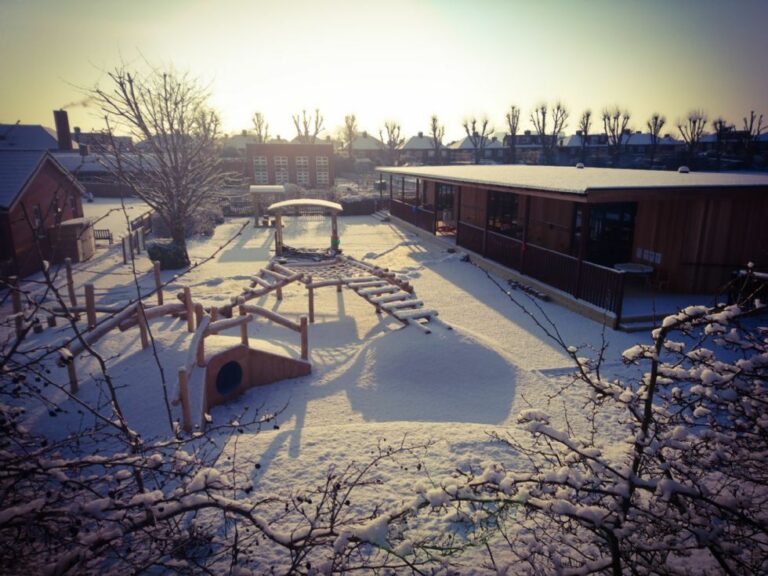At a Glance
- Building Bulletin 104 provides non-statutory but widely followed area guidelines for SEND settings
- SEND classrooms require more space per pupil than mainstream – typically 49-66 m² depending on needs, with class sizes of 6-12 pupils
- Early Years SEND settings need 49-66 m² for groups of 6-10 children (significantly larger per-pupil than mainstream)
- Specialist spaces like therapy rooms, sensory areas, and hygiene facilities have their own size requirements
- Acoustic design, natural light, and flexible layouts are just as important as raw floor area
- The government’s £740 million investment in SEND places makes understanding these requirements more important than ever
Getting classroom size right is fundamental to creating effective learning environments for pupils with special educational needs and disabilities. Too small, and you compromise safety, accessibility, and the ability to provide proper support. Too large without purpose, and you’ve wasted precious budget that could have been spent elsewhere.
With the challenges facing SEND schools across the UK continuing to intensify – rising demand, funding pressures, and a shortage of specialist places – schools need to make every square metre count. This guide explains the space requirements for different SEND settings, the regulations that inform them, and the design considerations that turn adequate space into truly effective learning environments.
At TG Escapes, we’ve designed and built bespoke SEN, SEND, and SEMH classrooms for schools across the UK. This guide draws on that experience alongside the official guidance to help you plan spaces that genuinely work for your pupils.
Why Classroom Size Matters in SEND Settings
Space isn’t just about comfort – it directly affects learning outcomes, safety, and wellbeing. Research consistently shows that tailored environments benefit SEND students in measurable ways, from improved concentration to reduced anxiety.
In SEND settings, adequate space is essential for several reasons:
- Mobility and accessibility – pupils using wheelchairs, walking frames, or other mobility aids need room to move safely. Doorways, corridors, and classroom layouts must accommodate equipment without creating bottlenecks or hazards.
- Higher staff-to-pupil ratios – SEND classrooms typically have two or three adults working alongside the teacher, including teaching assistants, therapists, or support staff. These additional bodies need space to work effectively without crowding pupils.
- Specialist equipment – from hoists and standing frames to sensory equipment and communication aids, SEND settings often require storage and operational space for equipment that mainstream classrooms don’t need.
- Therapeutic approaches – many SEND settings incorporate movement breaks, sensory activities, or therapeutic interventions that simply can’t happen in cramped conditions.
- Emotional regulation – pupils who become overwhelmed need space to move away from triggers, access quiet areas, or engage in calming activities. Overcrowded rooms escalate rather than de-escalate challenging situations.
Understanding Building Bulletin 104
Building Bulletin 104 (BB104) is the Department for Education’s guidance on area requirements for SEND and alternative provision settings. Published in December 2015, it replaced the earlier BB102 and remains the primary reference for planning SEND spaces in England.
BB104 is non-statutory – schools aren’t legally required to follow it – but it’s widely used by architects, local authorities, and the Education and Skills Funding Agency when designing or approving new SEND provision. If you’re preparing a Condition Improvement Fund (CIF) bid or working with your local authority on new places, BB104 will almost certainly inform the conversation.
The guidance covers four types of provision:
- Special schools – both ambulant and non-ambulant settings
- Alternative provision (AP) – for pupils who can’t attend mainstream schools
- Specially resourced provision (SRP) – within mainstream schools
- Units – attached to mainstream schools
For a detailed breakdown of the regulatory framework, our guide to SEND building regulations covers the key requirements you need to know.
The fundamental principle throughout BB104 is that SEND settings need more space per pupil than mainstream schools. This reflects smaller class sizes, higher staffing ratios, and the additional facilities required to meet complex needs.
The Four Broad Categories of SEN
Before diving into specific measurements, it’s worth understanding how the UK typically categorises special educational needs. This matters because different needs drive different space requirements.
- Communication and interaction – includes speech, language and communication needs (SLCN) and autistic spectrum disorder (ASD). Pupils in this category often benefit from reduced visual and auditory stimulation, quiet spaces for regulation, and clear, predictable room layouts.
- Cognition and learning – covers moderate learning difficulties (MLD), severe learning difficulties (SLD), profound and multiple learning difficulties (PMLD), and specific learning difficulties (SpLD). PMLD settings in particular require significantly more space per pupil to accommodate medical equipment, hoisting facilities, and the physical support many pupils need.
- Social, emotional and mental health (SEMH) – relates to pupils whose behaviour or emotional state affects their ability to learn in mainstream settings. These environments often need breakout spaces, calm-down areas, and layouts that minimise confrontation while maintaining sight lines for supervision.
- Sensory and physical needs – includes visual impairment (VI), hearing impairment (HI), multi-sensory impairment (MSI), and physical disability (PD). Acoustic treatment, lighting design, and physical accessibility are particularly critical for these pupils.
Most special schools cater for pupils across several of these categories, which is why BB104 provides ranges rather than fixed figures – the exact requirements depend on your specific pupil population.
Early Years SEND Space Requirements
For nurseries and early years settings working with children with SEND, space requirements are significantly higher than mainstream provision. Young children learn through movement, exploration, and play, and those with additional needs often require even more room to develop safely.
BB104 specifies the following for SEND early years settings:
| Setting Type | Typical Capacity | Recommended Area Range | Standard Size |
| Nursery/Reception (ambulant) | 10 children | 49-59 m² | 55 m² |
| Nursery/Reception (non-ambulant) | 6 children | 58-66 m² | 62 m² |
Source: Building Bulletin 104, Figure 20
Compare this to mainstream early years provision, where EYFS requires just 2.3 m² per child for three-year-olds – a mainstream nursery for 26 children might occupy 60-70 m². A specialist SEND nursery of similar size would accommodate just 6-10 children, providing roughly five to ten times more space per child for proper support, equipment, and therapeutic activities.
Free-flow access to outdoor space is particularly valuable in early years SEND settings. If you’re considering a standalone building, designs that incorporate covered decking or direct garden access can significantly enhance provision without requiring additional indoor floor area.
Primary School SEND Classroom Sizes
Space requirements at primary level vary considerably depending on the type of provision. We’ve broken this down into three categories.
Mainstream Schools with SEND Pupils
Standard mainstream classrooms accommodate 30 pupils in approximately 62 m² for Reception and Key Stage 1 or 55 m² for Key Stage 2. These figures come from Building Bulletin 103 (the mainstream equivalent of BB104) and assume that pupils with SEND will have access to additional support spaces elsewhere in the school.
If your mainstream school has a high proportion of pupils with SEND, BB103 advises using the maximum recommended areas rather than the minimum. In practice, this means allowing extra circulation space, wider gaps between furniture, and room for additional adults.
Dedicated SEND Units
Schools with a dedicated unit for SEND pupils need larger classrooms for smaller groups. BB104 recommends that Units follow the same zone specifications as special schools accommodating the same needs – typically 49-56 m² for up to 12 ambulant pupils, or 58-66 m² for 6 non-ambulant pupils.
Units typically also require:
- Small group rooms (15-20 m²) for withdrawal work or therapy
- A quiet space for pupils who need to regulate
- Accessible toilet and changing facilities
- Storage for specialist resources
Special Schools
Special schools have the most varied requirements because they cater for such diverse needs. BB104 uses formulas based on pupil numbers and need types, but as a general guide:
| Classroom Type | Typical Class Size | Recommended Area Range | Standard Size |
| Ambulant (MLD, SLD) | 12 | 49-56 m² | 55 m² |
| Non-ambulant (PMLD, PD) | 6 | 58-66 m² | 62 m² |
| Severe SEMH | 8 | 42-52 m² | 48 m² |
| Severe autism (ASD) | 6 | 44-53 m² | 48 m² |
Source: Building Bulletin 104, Figure 20
Non-ambulant settings consistently require more space to accommodate wheelchairs, hoists, standing frames, and the physical support pupils need during transfers and personal care.
Secondary School SEND Classroom Sizes
Secondary provision follows similar principles to primary, with adjustments for older pupils and more complex timetabling.
Mainstream Secondary Schools
Standard secondary classrooms accommodate 30 pupils in approximately 55 m², though specialist rooms have higher requirements – ICT-rich classrooms need around 62 m², and practical workshops can require 97 m² or more for 16-20 pupils.
For pupils with SEND in mainstream secondary settings, access to specialist spaces matters more than classroom size alone. A properly equipped resourced provision base can enable pupils to access mainstream lessons while having a safe, appropriately sized space for targeted support.
Dedicated Units and Resourced Provision
Secondary SEND units follow the same zone specifications as special schools – typically 49-56 m² for up to 12 ambulant pupils. However, secondary units often need to accommodate subject-specific equipment or activities, which can push requirements higher.
Resourced provision classrooms (smaller spaces within mainstream schools for targeted support) typically need 49-56 m² for ambulant pupils, with smaller group rooms of 15-20 m² for intensive intervention work.
Special Schools (Secondary)
Secondary special schools need to balance classroom requirements with access to practical spaces for vocational learning, life skills, and curriculum enrichment. The per-pupil space requirements remain similar to primary, but the overall building footprint tends to be larger to accommodate specialist facilities.
We explore the full range of provision in our guide to the different types of SEND classrooms we’ve designed and built.
| Classroom Type | Typical Class Size | Recommended Area Range | Standard Size |
| Ambulant (MLD, SLD) | 12 | 49-56 m² | 55 m² |
| Non-ambulant (PMLD, PD) | 6 | 58-66 m² | 62 m² |
| Severe SEMH | 8 | 42-52 m² | 48 m² |
| Severe autism (ASD) | 6 | 44-53 m² | 48 m² |
Source: Building Bulletin 104, Figure 21
Specialist Spaces – Sensory Rooms, Therapy Areas, and More
Classroom size is only part of the picture. Effective SEND provision typically requires a range of specialist spaces, each with their own area requirements.
Therapy Rooms
BB104 specifies minimum sizes for therapy spaces:
- 12 m² for ambulant pupils
- 15 m² for non-ambulant pupils (to accommodate wheelchairs and treatment plinths)
Schools with high therapy needs – particularly those working with speech and language therapists, occupational therapists, or physiotherapists – may need multiple therapy spaces or larger multi-purpose rooms.
Sensory Rooms
Sensory rooms aren’t covered by specific area requirements in BB104, but effective provision typically needs 15-25 m², depending on the equipment installed and number of pupils using the space simultaneously.
Key design considerations include:
- Dimmable or controllable lighting (avoiding harsh fluorescents)
- Sound insulation from adjacent spaces
- Easy-clean, tactile-friendly surfaces
- Sufficient power outlets for sensory equipment
- A calm, low-stimulation colour scheme
Hygiene Rooms
For pupils requiring personal care support, hygiene rooms need adequate space for hoists, changing beds, and staff to work safely. BB104 recommends these are located conveniently for classrooms serving non-ambulant pupils, with minimum dimensions allowing full hoist coverage of the changing area.
Breakout and Quiet Spaces
Smaller breakout spaces (8-15 m²) allow pupils to take sensory breaks, complete withdrawal work, or calm down after becoming dysregulated. These work best when visible from the main classroom but acoustically separate.
Beyond the Numbers – Design Considerations
Meeting minimum area requirements doesn’t automatically create effective SEND spaces. The design essentials of a modern SEND classroom go well beyond square metres.
Acoustics
Pupils with hearing impairments, autism, ADHD, or speech and language difficulties are particularly sensitive to noise. BB93 (Acoustic Design of Schools) sets performance standards, but SEND settings typically need to exceed mainstream requirements.
Key acoustic considerations include:
- Lower ambient noise levels than mainstream (below 35 dB)
- Shorter reverberation times, especially at low frequencies
- Sound insulation between teaching spaces
- Careful positioning of mechanical ventilation to minimise background noise
For special schools or units, involving an acoustician early in the design process pays dividends.
Natural Light and Ventilation
Biophilic design principles are particularly valuable in SEND settings. Natural light supports circadian rhythms, reduces stress, and creates more pleasant learning environments. Good ventilation maintains air quality without creating distracting draughts or noise.
Our buildings incorporate floor-to-ceiling glazing, and mechanical ventilation with heat recovery (MVHR) to maximise natural light and air quality while maintaining comfortable, controlled environments.
Flexibility
Pupil needs change over time, and the best SEND spaces can adapt. Furniture should be movable rather than fixed. Zones should be created through flexible means – storage units, screens, or soft furnishings – rather than permanent walls. This allows spaces to evolve as cohorts change or as individual pupils develop.
When thinking about future flexibility, modular SEND buildings offer particular advantages – they can be extended or reconfigured as needs change.
How TG Escapes Approaches SEND Classroom Design
We’ve been designing and building SEND facilities for over a decade, and every project starts with understanding the specific needs of your pupils and setting. There’s no one-size-fits-all solution – a classroom for pupils with PMLD looks very different from one designed for pupils with SEMH needs.
Our recent projects demonstrate this bespoke approach:
The Oaks Specialist College required a specialist SEND learning centre to accommodate learners who need hoisting or physical support during the day. The 435m² building includes five learning spaces – a sensory room, media suite, and specialist workshop with ceiling track hoists and accessible self-care facilities.
Beacon Hill School required a 60-place SEND facility with 10 classrooms, 2 PMLD bases, hygiene rooms, sensory spaces, and generous storage for specialist equipment. The building was designed specifically around the needs of pupils with high-dependency needs and profound and multiple learning disabilities.Woking High School presented a particular design challenge – creating a specialist hub for visually impaired students that achieved net zero in operation while meeting the specific acoustic requirements of pupils with VI.
Every project benefits from our understanding that going beyond basic accessibility creates spaces where pupils genuinely thrive.
Planning Your SEND Space
With the government’s £740 million investment creating 10,000 new SEND places, and growing recognition that mainstream schools need better resourced provision, demand for well-designed SEND spaces has never been higher.
If you’re planning new SEND provision – whether a single classroom, a resourced provision unit, or an entire special school building – getting the sizing right from the start saves significant time and cost later.
We offer a free design consultation to help you explore what’s possible on your site, within your budget, and for your specific pupil needs. Our in-house architects understand BB104, acoustic requirements, accessibility standards, and the practical realities of creating spaces that work for pupils with complex needs.
To see examples of our SEND work, visit our SEND case studies, or explore our ranges and prices to understand typical costs. When you’re ready to discuss your project, get in touch for a no-obligation conversation about how we can help.
Summary – Quick Reference Guide
| Setting | Pupils | Recommended Area | Standard Size |
| SEND nursery/reception (ambulant) | 10 | 49-59 m² | 55 m² |
| SEND nursery/reception (non-ambulant) | 6 | 58-66 m² | 62 m² |
| Primary/Secondary classroom (ambulant) | 12 | 49-56 m² | 55 m² |
| Primary/Secondary classroom (non-ambulant) | 6 | 58-66 m² | 62 m² |
| Classroom (severe SEMH) | 8 | 42-52 m² | 48 m² |
| Classroom (severe autism) | 6 | 44-53 m² | 48 m² |
| Small group room (ambulant) | 4-6 | Zone F | 15-20 m² |
| Therapy space (ambulant) | N/A | 12 m² minimum | — |
| Therapy space (non-ambulant) | N/A | 15 m² minimum | — |
| Sensory room | Varies | Zone F-G | 15-25 m² |
These figures provide starting points. Your specific requirements will depend on pupil needs, staffing models, and the specialist equipment or activities you need to accommodate. The full BB104 guidance, available on GOV.UK, provides detailed formulas for calculating precise requirements.




